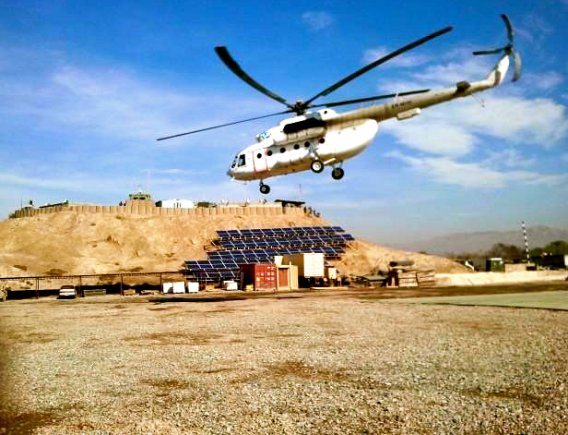Soldiers are enlisting the sun’s power in Afghanistan.
Ten solar generators are now providing Special Forces Soldiers in distant outposts the energy they need to accomplish their mission. And, these generators are allowing them precious more time to train Afghan forces and win the friendship of local Afghans.
The key benefit of solar is savings in fuel. Fuel makes up a significant portion of weight and volume that has to be transported great distances to remote locations in Afghanistan and elsewhere.
“During World War II, we used (an average of) one gallon of fuel per day, per Soldier,” said Richard G. Kidd IV, deputy assistant secretary of the Army for Energy & Sustainability, with the Office of the Assistant Secretary of the Army for Installations, Energy & Environment. “We now use (an average of) 20 gallons per day, per Soldier, and in Afghanistan, over 40 percent of that fuel is used to produce electricity.
“With solar power, we are cutting the supply of fuel needed in half, from 40 to 20 percent,” he added. That is the first of at least five benefits, he said.
Because the solar generators, which are hybrid — solar/diesel — don’t need as much fuel as traditional diesel generators, Soldiers are spending less time moving to drop zones, securing those areas so aircraft can land or airdrop and collecting and transporting the fuel back to the outpost, according to Kidd, who has been working with others in the Army’s Installations, Energy & Environment Department, G3/4 and contract personnel, to field these devices.
And secondly, those air assets that would have been used to transport fuel are now available for other important missions, he added.
Each 28-kilowatt mobile solar generator system can provide power for about 30 Soldiers, according to Dennis Bohannon, a spokesman for the Army’s Installations, Energy & Environment Department.
“The 10 systems now in Afghanistan can provide about 700 megawatt hours per year, saving approximately 460,000 gallons of fuel,” he said. “That is equal to pulling 185 M978 Heavy Expanded Mobility Tactical fuel trucks out of our convoys per year. In terms of cost these systems pay for themselves in fuel savings in about two-and-a-half months.”
Each solar system is completely contained in a 20-foot container — solar panels, batteries, communications gear and generator, according to Dan Rice, president, SunDial Capital Partners, the company that makes the patented technology.
The SunDial systems proved themselves after a very successful two year Special Operations Forces-run program in Afghanistan. They were shown to reduce fuel significantly, save taxpayer dollars and increase combat capability, according an April 2012 U.S. Special Operations Command report “Mobile Smart Power Initiative,” initiated by now-retired Adm. Eric T. Olson, USSOCOM commander.
A third savings, Kidd said, is in repair costs and down-time.
“The majority of our (traditional diesel) generators are ‘wet stack,'” he said, “meaning they are (prone) to breaking down sooner. We’re also overtaxing our generator mechanics, who are having a difficult time repairing them all.”
Wet stacking is a condition where unburned fuel is discharged through the exhaust system, which happens when the engine is running at the low-end capacity of its maximum output, he explained. “Generators like to operate at 75 to 80 percent (capacity), not the 20 to 30 percent they often run at.”
The new solar generators are “networked together in an intelligent manner so that one generator will service the whole load all the time,” thereby utilizing greater capacity, he said.
“If more power is needed, they come on-line in a staggered manner” so each is operating at the ideal capacity that will extend the life of the generator, as well as save some of the fuel which would otherwise be discharged through the exhaust, he said.
Of course when the sun is shining, the batteries are being charged so no fuel is needed and when the sun is not shining, the batteries will continue to provide stored power until it is expended.
A fourth benefit, Kidd said, was “unintended” but, nonetheless, welcome.
Soldiers in Afghanistan are using some “sophisticated” electronic equipment such as sensors and cameras “requiring high-quality power to maintain consistency in hertz and frequency,” he said.
“You don’t get that (quality) when you’re connected to (diesel) generators, but you do when you’re connected to batteries. So, operational readiness rates of sensors and communications equipment have gone up dramatically wherever solar has been deployed.”
A fifth benefit is that Soldiers who have solar generators now have not only enough power for themselves, but enough to supply local Afghan villages, he said, and “this will help Special Forces’ public engagement and village stability missions.”
Kidd said the Army intends to make this technology more widely available, not only to the operating forces, but eventually to the installations. These and other renewable energy sources systems are being tested and the Army’s Rapid Equipping Force is working to deliver these as soon as possible, he said.
“We’re on the cusp of making intelligent, informed, power management a feature on the battlefield,” Kidd concluded.










